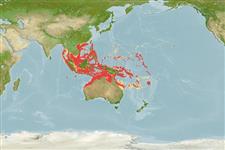Common names from other countries
Classification / Names / Names
Namen | Synonyme | Catalog of Fishes (gen., sp.) | ITIS | CoL | WoRMS
Environment: milieu / climate zone / depth range / distribution range
Ökologie
Riff-verbunden; tiefenbereich 0 - 750 m (Ref. 275), usually 60 - 240 m (Ref. 1695). Tropical; 20°N - 24°S, 92°E - 180°E (Ref. 1695)
Indo-Pacific: from Andaman Islands to Philippines, Australia and Fiji.
Length at first maturity / Size / Gewicht / Alter
Maturity: Lm ? range ? - ? cm Max length : 22.2 cm SHD Männchen/unbestimmt; (Ref. 1695); max. veröff. Gewicht: 1.7 kg (Ref. 1695)
Umbilicus filled in with concretion; flame-striped color pattern extending across nearly entire shell
Occurs on the continental shelf and slope. Prefers hard bottoms particularly coral reefs (Ref. 88739), on steep faces (Ref. 106682). Exhibits diel vertical migration. Broken shell washed up on beach (Ref. 88739).
Life cycle and mating behavior
Geschlechtsreife | Fortpflanzung | Ablaichen | Eier | Fecundity | Larven
Members of the class Cephalopoda are gonochoric. Male and female adults usually die shortly after spawning and brooding, respectively. Mating behavior: Males perform various displays to attract potential females for copulation. During copulation, male grasp the female and inserts the hectocotylus into the female's mantle cavity where fertilization usually occurs. Life cycle: Embryos hatch into planktonic stage and live for some time before they grow larger and take up a benthic existence as adults.
Jereb, P. and C.F.E. Roper (eds.). 2005. (Ref. 1695)
IUCN Rote Liste Status (Ref. 130435)
CITES Status (Ref. 108899)
Not Evaluated
Nutzung durch Menschen
Fischereien: kommerziell
| FishSource |
Tools
Internet Quellen
Estimates based on models
Preferred temperature
(Ref.
115969): 14.5 - 27.9, mean 23.7 (based on 692 cells).
Verwundbarkeit
Low vulnerability (12 of 100).
Preiskategorie
Unknown.
